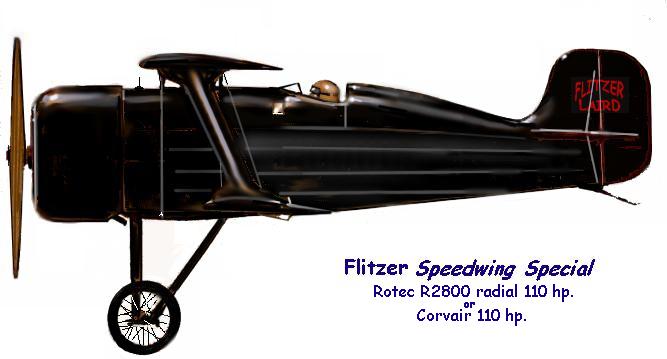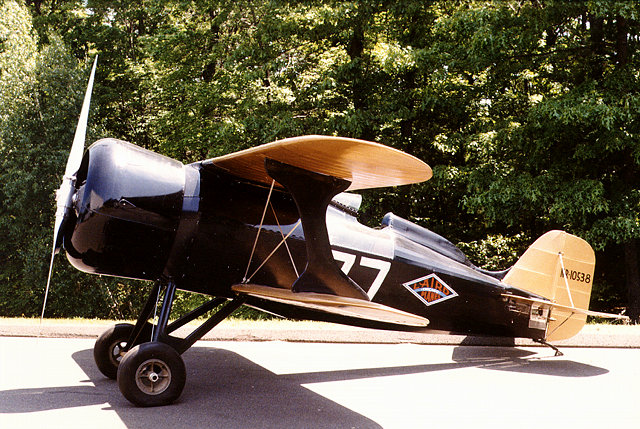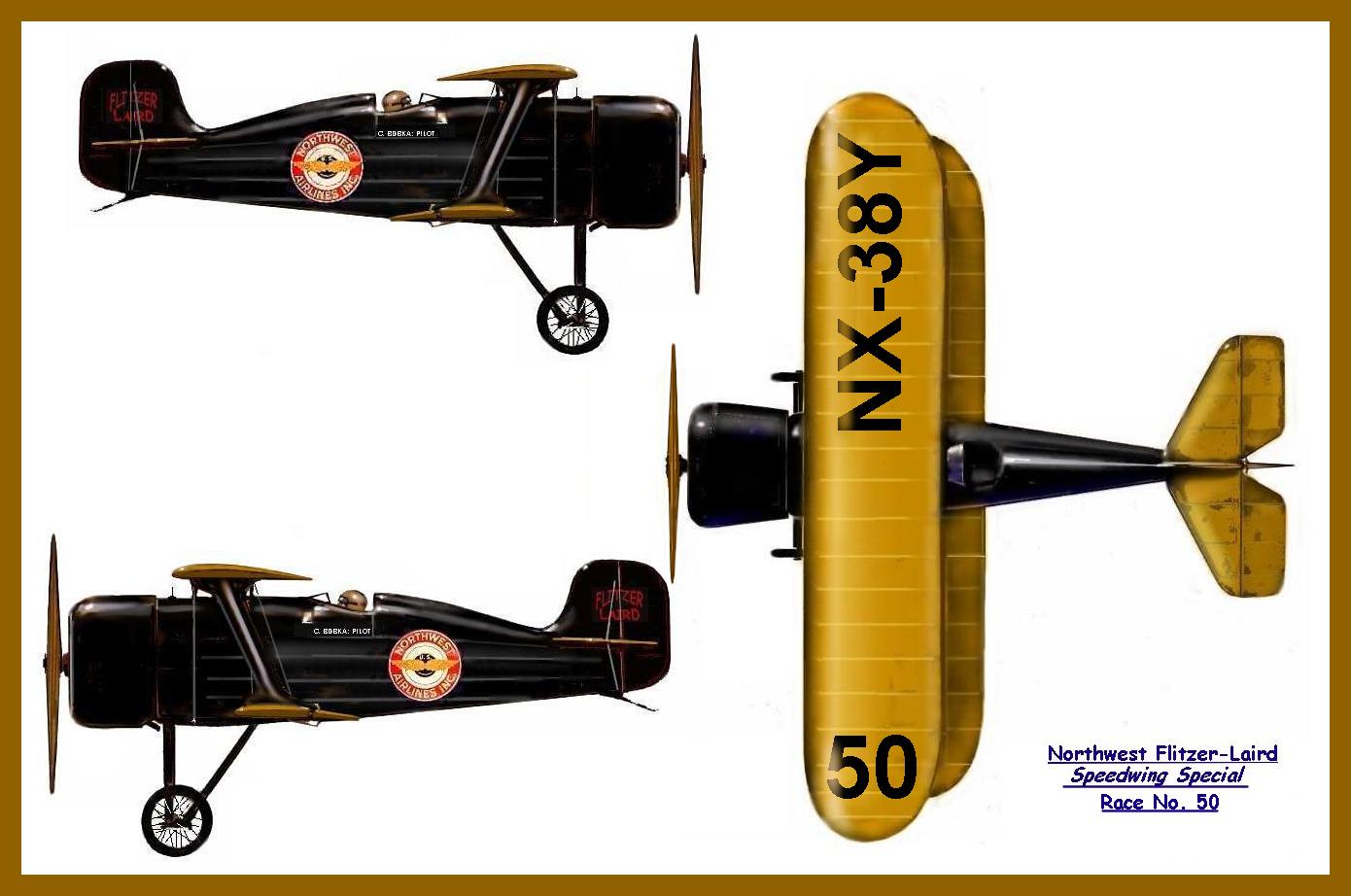


Further to the thrilling fly-bys of Rupert's Z-21, and the possibilty of Flitzer Formula air racing, this is the version of the freestyle Laird, the 'Flitzer Speedwing Special', I was discussing in some emails recently. It pre-dates the Solution and Super Solution, and is blessed with reasonable forward view through a standard Z-21 'A' frame cabane. The 'I' struts are per original.
It is loosely- based on the Stummelflitzer, but with no ailerons on the upper plane and a continuous trailing edge. Motor could be either an exposed, or speed-ring- cowled Rotec R2800, or a cosmetically full-cowled Corvair flat six.
Either way, it would be a dramatic sight at 130 mph!
In fact this machine is the first of what was the intended purpose of the Z-1 prototype when it was first drafted in the late 1980s, as a proof-of-concept vehicle for a range of raceplanes, sportplanes, and fighter biplanes of the Golden Age.
Cheers,I am trying to come to grips with the origins of the Laird Flitzer. It is obviously a product of the last 10 days or so but I am trying to pin its origins. Can you recap for the group how it came about and what put you over the edge on it?
Cheers!Very briefly, the original Flitzer design was, as I've mentioned, a 'proof-of-concept' vehicle for VW-powered biplanes, to determine the potential performance of a series of proposed scaled-down fighters, sportplanes and racers for a 'Golden Age' revival 'on a budget'.
However, the basic aeroplane became a 'hit' in its own right and then spawned a number of 'development' aeroplanes with specific missions, including the two seater.
Prior to this I had experimented with the pilot's cockpit view from a mock-up of the Laird Solution, designed around a Salmson 5AQ radial engine that I then possessed, before abandoning the idea, in 1984, in favour of the Tigerfalk, which didn't compromise on cockpit view.
An expensive house move and the loss of the motor resulted in my designing the Flitzer in a 'moment of frustration'. The Tigerfalk languishes in my workshop for lack of a suitable, affordable aero engine. The superlative R2800 is a perfect match for the Tigerfalk.
Meanwhile, the most advanced of the Flitzers, the F.2 Tiger was designed around an old Cirrus 100 hp. motor, which I do possess but which may require a substantial overhaul with no guarantee that it will be useable eventually. The Cleveland 200 was also designed around this engine, which is not suitable for installation in the Tigerfalk, not with the swept wing anyway, and it still wouldn't look right with the 'hunched' compact fuselage, which was designed for the right 'look' with a radial, all my designs being 'style-led'.
The F.2 Tiger itself was partly influenced by the Speedwing Junior with the Ranger, as well as the British Arrow Active ll, both with 'I' struts, but it (the Tiger) featured a more modern, split-axle undercarriage than the Laird.
Your additional Laird information, with the photographic evidence of pre-Solution single seat Laird 'racing' types featuring a clear foward view, rekindled my appreciation of these aeroplanes, as they were anyway of small size, and compared well with the simple Flitzer design philosophy, namely:
 1/ No upper centre section and an 'A' frame cabane.
1/ No upper centre section and an 'A' frame cabane.The combination of this, with the USA 35B instead if the M6, suggested that with a suitable engine, a simple Flitzer development could finally be built that reproduced, in freestyle form anyway, a classic 'racing aeroplane', as as partner to the Cleveland 200, which is itself a 'generic' US 1930s racer.
All that was missing was the engine. But with the pilot sitting further aft, the Corvair suddenly entered the arena as the viable alternative to the more expensive R2800. Part of this enthusiasm was driven, at first, by the existence of a 220 hp. Ivchenko radial and the idea of building it bigger for this motor, probably with a steel-tube fuselage. But then the practicalities, new mandatory insurance costs, and cost of operation of this motor led me to consider the raison d'etre of the Flitzer prototype as a progenitor for a range of low cost classical types, and thus the idea was born for a smaller machine based more closely on the Stummelflizter with a Stummel upper wing, sans ailerons, and a Flitzer Z-21 bottom wing, both cropped to approximately 17' 6" and 15' respectively, and equipped with elliptical tips.
Finally, what has 'pushed me over the edge', so to speak, was watching and listening to Rupert's Z-21 perform with the AeroVee on the 'wrong' propeller. This indicated the potential of the airframe for a Flitzer Formula type race, which I had always thought could provide a spectacular event for such well-matched 'vintage' style machines.
Possibly the Corvair with a suitable re-drive that would not extend the already long nose of the Flitzer-Laird, would overcome any additional drag from the cosmetic cowling, which is the only thing likely to detract from the performance of this little brute.
I attach a two-view image with the gold wings you prefer, appropriate to some of the Lairds. I hope the above information covers the inspirations and influences which have produced this latest evolution and design spec.
Best regards,
looks very Classic, black and gold!
Is there going to be stringers on the side of the fuselage to make it more round?
I was under the impression that it would be a bullet cowling on the Corvair engined Flitzer Laird but I guess I was wrong (?!). Could make the speed increase if so done...a become a winner in the races...
RegardsYes, there will be stringers on the fuselage, with the section changing from elliptical just aft of the firewall bulkhead, to a flattened section with the stringers disappearing just ahead of the tailplane spar.
The Z-3 still has the bullet cowl, but a 'Laird' can only really have a radial cowling, even with a flat six!
Cheers,